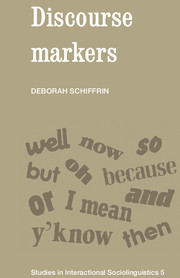Book contents
- Frontmatter
- Contents
- Acknowledgements
- Intonation and transcription conventions
- 1 Background: What is discourse?
- 2 Prelude to analysis: Definitions and data
- 3 Questions: Why analyze discourse markers?
- 4 Oh: Marker of information management
- 5 Well: Marker of response
- 6 Discourse connectives: and, but, or
- 7 So and because: Markers of cause and result
- 8 Temporal adverbs: now and then
- 9 Information and participation: y'know and I mean
- 10 Discourse markers: Contextual coordinates of talk
- Notes
- References
- Author index
- Subject index
10 - Discourse markers: Contextual coordinates of talk
Published online by Cambridge University Press: 05 June 2012
- Frontmatter
- Contents
- Acknowledgements
- Intonation and transcription conventions
- 1 Background: What is discourse?
- 2 Prelude to analysis: Definitions and data
- 3 Questions: Why analyze discourse markers?
- 4 Oh: Marker of information management
- 5 Well: Marker of response
- 6 Discourse connectives: and, but, or
- 7 So and because: Markers of cause and result
- 8 Temporal adverbs: now and then
- 9 Information and participation: y'know and I mean
- 10 Discourse markers: Contextual coordinates of talk
- Notes
- References
- Author index
- Subject index
Summary
The philosopher Abraham Kaplan suggests that scholary inquiry is guided by two divergent logics: a logic in use and a reconstructed logic. According to Kaplan (1964): ‘A great deal hinges on whether science is viewed as a body of propositions or as the enterprise in which they are generated, as product or as process. An account of the norms bearing on the finished report of an investigation might well be expected to differ from one concerned with the conduct of the investigation itself’ (p. 7). Kaplan suggests that ‘science as process’ is guided by a logic in use, and ‘science as product’ is guided by a reconstructed logic. And there is a crucial difference between them: ‘we can no more take them to be identical or even assume an exact correspondence between them, than we can in the case of the decline of Rome and Gibbon's account of it, a patient's fever and his physician's explanation of it’ (p. 8).
Most academic reports are written according to a reconstructed logic, but much of the work which underlies such reports is the product of a logic in use. Although I have followed a reconstructed logic in most of this book, I think it would be helpful to recount briefly my logic in use – for it not only explains why I included what I did, but it motivates the questions that my inquiry into discourse markers sought to answer, as well as the answers which I present in this concluding chapter.
Information
- Type
- Chapter
- Information
- Discourse Markers , pp. 312 - 330Publisher: Cambridge University PressPrint publication year: 1987
Accessibility standard: Unknown
Why this information is here
This section outlines the accessibility features of this content - including support for screen readers, full keyboard navigation and high-contrast display options. This may not be relevant for you.Accessibility Information
- 2
- Cited by
